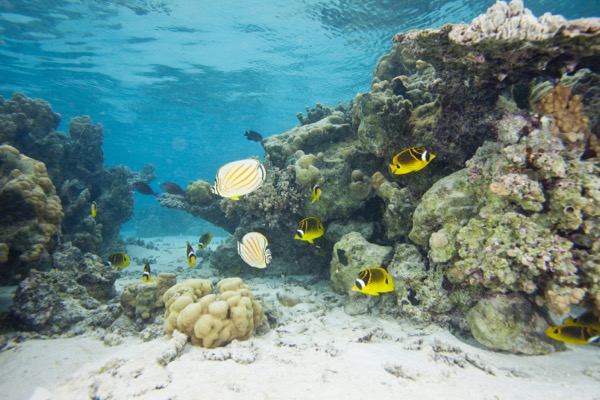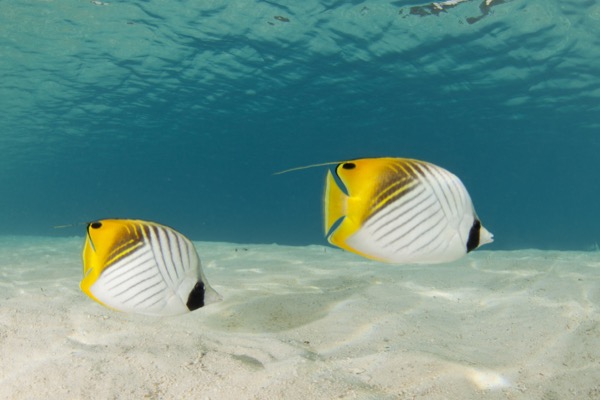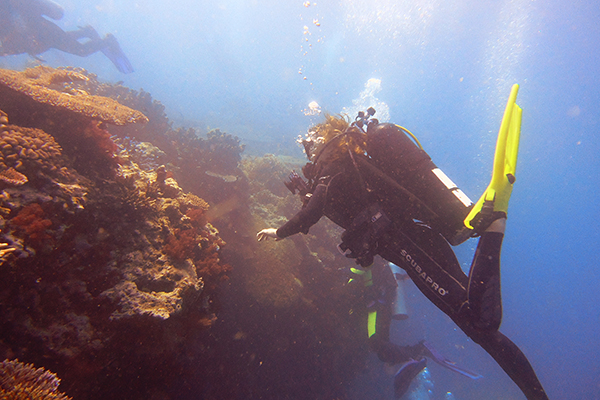

Coral, seaweed and fish
UD researchers evaluate how coral-seaweed interactions affect coral associated reef fishes
8:36 a.m., Jan. 4, 2016--A new study by the University of Delaware’s Danielle Dixson and Rohan Brooker has shown that butterflyfishes avoid coral that has come in contact with seaweed.
The paper, which appeared this week in the Nature publication Scientific Reports, is the first to critically evaluate the impact coral-seaweed interactions will have on coral associated reef fishes, a key component of coral reef resilience.
Research Stories
Chronic wounds
Prof. Heck's legacy
In controlled patch experiments in Fiji, the study found that coral-feeding and coral-associated butterflyfishes overwhelmingly avoided corals that had contact with seaweeds. This was true regardless of whether the visual cue of the seaweed itself was present, leading the researchers to conclude that the coral-seaweed interaction produced chemical cues that were left behind even after the seaweed was removed.
“Butterflyfish are kind of like the canary in the coal mine,” said Dixson, an assistant professor in the School of Marine Science and Policy, which is housed in the College of Earth, Ocean, and Environment.
“When problems start to happen, they will be hit first because of their strong reliance on coral for food and shelter, so understanding their ecology is important before reefs become too degraded or just aren’t there.”
Co-authors on the paper include UD post-doctoral fellow Brooker, the paper’s lead author, and Simon Brandl from Smithsonian Environmental Research Centre and James Cook University in Australia.
Coral reefs in crisis
Since the 1980s, coral reef cover has decreased by 80-90 percent in the Caribbean and by 50 percent in the tropical Pacific. The dramatic changes are a result of the synergistic impacts of climate change, overfishing, eutrophication and pollution. Formerly healthy reefs with many species and complex coral-dominated communities are being converted at an alarming rate to wastelands dominated by seaweeds.
This shift is compromising delicate coral reef ecosystems, reducing reef productivity and resilience and also local food and tourism opportunities, and decreasing habitat for marine organisms. Yet, little is known about how this shift affects coral reef fishes and organisms.
While micro-algae have a symbiotic relationship with coral, macro-algae such as seaweed compete with coral for space on the reef. Seaweed grows faster than coral, but plant-eating fish known as herbivores typically keep the reef ecosystem in check.
As more reefs degrade, however, scientists continue to struggle to understand why. Top-down theories suggest overfishing of predator fish leaves fewer herbivores to eat the seaweed. Bottom-up viewpoints contend that rising temperatures and runoff from fertilizers on land cause the seaweed to over grow, throwing the ecosystem out of whack.
“Realistically, both things are happening,” Dixson said.
She believes other things are happening, too. Her research team’s study findings suggest that seaweeds alter the coral’s biochemistry, and that increased seaweed cover may cause further coral declines by changing the ways organisms forage or interact there.
The paper grew out of Dixson’s post-doctoral work with Mark Hay, a professor of biology at the Georgia Institute of Technology who studies seaweed-coral competition.
“We know from Mark’s work that seaweed placed near coral improves the seaweed’s taste because the algae spends its energy fighting coral instead of producing nasty chemicals to deter herbivorous fishes. My study looked at the other side of the coin — how the presence of seaweed affects coral palatability in fish,” Dixson said.
In the experiment, Dixson videotaped and counted butterflyfish interactions with reefs that had chemically active (Galaxaura filamentosa) and chemically inactive (Sargassum polycystum) seaweeds and control reefs without seaweed. Because butterflyfish are territorial, she moved the experiment to multiple locations to ensure new butterflyfish visited the test site each time.
“Parents are always trying to find ways to add vegetables into their children’s diet, by hiding extra carrots in tomato sauce, for example. But what if the child could smell the carrots even without seeing them?” Dixson said. “It’s not about memory, there is something happening with the coral-seaweed interaction that makes the coral unattractive to butterflyfish.”
Whether the corals are chemically changing internally in a way that makes them less nutritious or they actually taste bad due to the energy expended to defend themselves against the seaweed is unknown.
The ripple effect
Then there is the ripple effect — how does this negative coral-seaweed interaction affect other reef organisms and what is the larger implication for the ocean if this imbalance continues to grow?
Drastic differences already can be seen in places like Fiji, where a beautiful coral reef can be found right next to a seaweed-choked wasteland. Seaweed overgrowth is a consequence of environmental change, but it is not as simple as more seaweed hurts coral and less corals hurts fish – there are animal behaviors that could be driving this, as well.
“Butterflyfish clearly have evolved the ability to detect changes or differences in coral reefs and are choosing habitat and food supplies based on these cues. If this pattern is present in other fish, it could have ramifications including putting undue pressure on healthy corals by overeating them while avoiding those they don’t like” Dixson said.
To begin answering these larger questions, Dixson said, requires adding behavioral effects into the mix of how scientists think about habitat degradation.
“We need to start understanding these interactive effects, especially the behavioral choices that could be exacerbating issues that we’re not even thinking to give fish credit for,” she said.
So, where does Dixson go from here?
She and Brooker plan to dive deeper into the chemistry of the coral-seaweed interaction to explore whether seaweed affects the coral’s nutrition, taste or something else they haven’t considered. They are also curious about whether coral-seaweed interactions affect a fish’s ability to chemically camouflage itself against predators.
“We know animals hunt with chemistry, so it makes sense that they would hide themselves with chemistry, too,” Dixson said. “Chemical camouflage is an emerging field with potential for helping us better understand how organisms interact and predator-prey dynamics. I think UD can be a leader in this field.”
This work was supported in part with funding from the National Science Foundation and the National Institutes of Health.
Article by Karen B. Roberts
Video by Richard Raspa
Photos courtesy of João Paulo Krajewski, Lab de Biogeografia e Macroecologia Marinha, Universidade Federal de Santa Catarina and Wildlife











